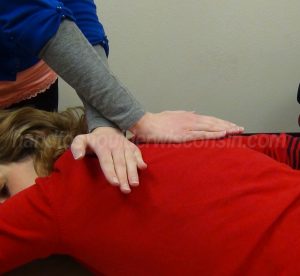Hand to Shoulder Center of Wisconsin has a team of orthopedic doctors and staff who have experience diagnosing and treating thoracic outlet syndrome. Learn more about this syndrome and contact our locations in Appleton or Green Bay, WI for more information.
What is Thoracic Outlet Syndrome?
Thoracic outlet syndrome, also known as TOS, is defined as a group of disorders that results from compression, injury, or irritation to the nerves, blood vessels, or muscles in the thoracic outlet region, which is located in the area between the neck and shoulder.
The thoracic outlet is a narrow space between the collarbone and first rib that houses a complex network of nerves, blood vessels and muscles. When the thoracic outlet region becomes compressed, the many blood vessels, nerves, and muscles are affected. The compression typically results in pain in the shoulder and at times to the base of the neck. Pain usually increases when raising the affected arm. Numbness and tingling along with weakness in the hands and fingers may also be felt without any symptoms in the neck or shoulder. Additional thoracic outlet syndrome symptoms may include swelling of the arm and discoloration due to possible clotting in the arm; arm fatigue and cold fingers may be present.
Thoracic outlet syndrome can affect people of all ages and gender; in general, it is most commonly seen in middle-aged women.
What are the Causes of Thoracic Outlet Syndrome?
Causes of thoracic outlet syndrome stem from irritation to the thoracic outlet. Such causes can occur from poor posture, physical trauma from an injury, or sporting activities, and/or anatomy abnormalities. Bony and soft tissue abnormalities are also causes of TOS. Some individuals are born with an extra rib limiting the space provided to the thoracic outlet. Pregnancy may also cause symptoms of thoracic outlet syndrome to occur. At times, symptoms of TOS can be disabling yet no known cause can be established.
The general types of thoracic outlet syndrome are:
- Neurogenic – this compression affects the brachial plexus region that is made up of a network of nerves from your spinal cord. Muscle movement along with sensation to your shoulder, arm, and hand can be affected by this condition.
- “Disputed thoracic outlet syndrome” is a type of neurogenic TOS. Chronic pain and numbness or tingling is felt in the entire arm with no known cause or injury. This is the most common type of TOS and typically responds very well to physical or occupational therapy.
- Vascular – this compression affects the veins or arteries in the thoracic outlet. Surgery is typically performed to restore the patency of the veins and/or arteries. This is rare and often will be referred to a vascular surgeon if surgery is considered.
Diagnosing thoracic outlet syndrome
Early detection and treating thoracic outlet syndrome appropriately is important. Our physicians at Hand to Shoulder Center are sub-specialty trained and experienced in all fingertips to shoulder conditions, including thoracic outlet syndrome treatment. A thorough examination along with an in depth review of your medical history reports will be performed by a licensed orthopedic surgeon. Thoracic outlet syndrome tests consist of visual and physical diagnostic testing; clinical testing involving the arms with combined head and neck motions are often performed to assist in the diagnoses.
Thoracic Outlet Syndrome Treatment
The mainstay of treatment for TOS is physical or occupational therapy. Therapy focuses on improving the soft tissue and joint mobility of the neck and pectoral region while increasing the strength and endurance of the muscles around the shoulder blade. Shoulder blade positioning is addressed with manual techniques, exercise and sometime with the use of tape. Good posture is also a critical part of treating TOS. In most cases, occupational or physical therapy can be very effective in treating TOS (Fig.1-3).
 Figure 1: Soft tissue techniques are performed by a licensed therapist |
 Figure 2: Manual therapy techniques |
 Figure 3: Thoracic outlet syndrome exercises improve shoulder blade mechanics with |
If you are overweight, lifestyle changes may be addressed as excess weight can cause stress to the shoulder muscles that support your collarbone which can cause issues in the thoracic outlet region.